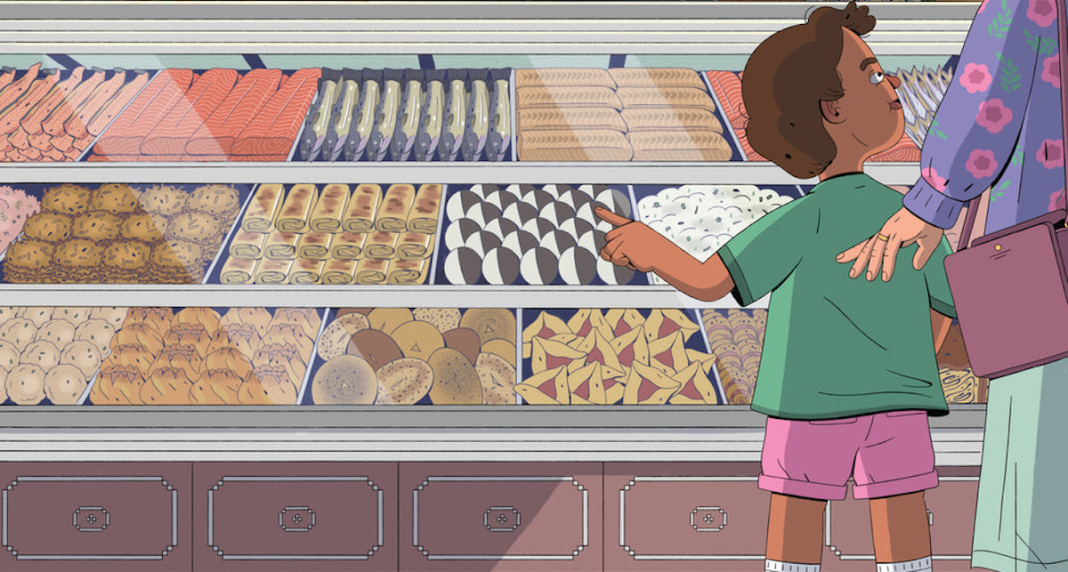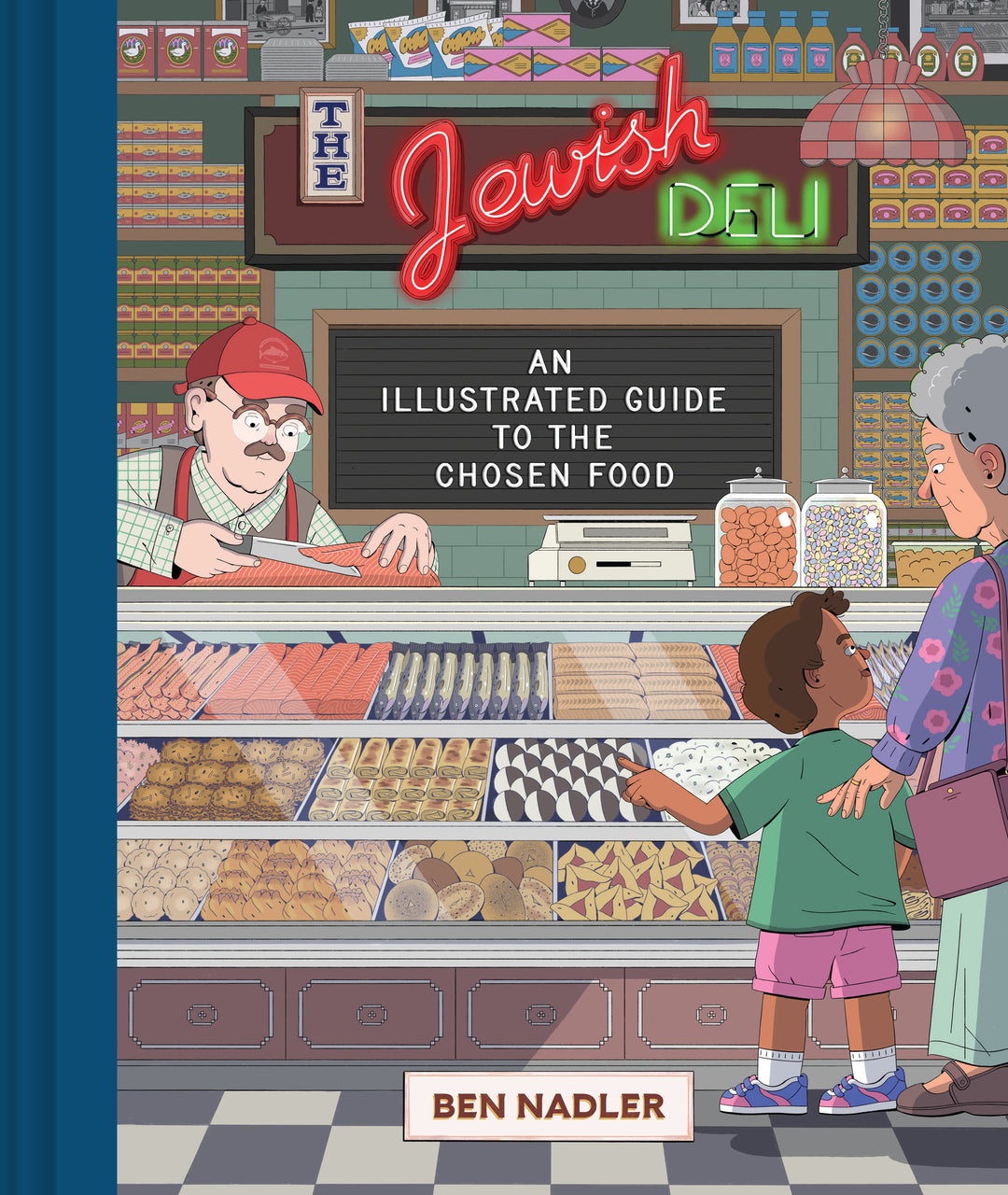Whether they are an expert in pastrami on rye or an amateur nosh-er, every reader will find something to like about The Jewish Deli: An Illustrated Guide to the Chosen Food by Ben Nadler. The upcoming nonfiction book is not only lavishly illustrated, but it also includes multiple pages in an outright sequential graphic narrative format (that’s right, people: COMICS). Scheduled for publication by Chronicle Books on July 11th, 2023, this long-time Jewish Deli enthusiast lept at the chance to check out the book and speak with creator Nadler over Zoom. We asked all about what goes into making a successful nonfiction comic, what constitutes the basics of Jewish deli food, and of course, all about his bagel preferences!
This interview has been edited for clarity and length.
REBECCA OLIVER KAPLAN: What’s your favorite bagel?
BEN NADLER: The best kind of bagel is an everything bagel. My favorite place in New York is Ess-a-Bagel, I think they have the best bagels.
KAPLAN: What was your research process for this book like?
NADLER: It was the pandemic, so I couldn’t travel as much as I wanted. It was a lot of Zooms with deli owners. I actually moved to New York right when I was beginning to write the book, coincidentally. So I was able to go around New York, which was really helpful, and talk to people and visit kitchens.
At first I said, “Oh, I get to travel around the country and eat at all these delis.” But I didn’t really get to do that. I wanted to take photos, too. But I just called everyone; everyone was really nice. I did lots of interviews.
And I read a lot of books. I checked out Kosher Nation: Why More and More of America’s Food Answers to a Higher Authority by Sue Fishkoff, Save the Deli: In Search of a Perfect Pastrami, Crusty Rye, and the Heart of Jewish Delicatessen by David Sax, and then Pastrami on Rye: An Overstuffed History of the Jewish Deli by Ted Merwin. Those were the big ones.
KAPLAN: Do you have a go-to Jewish deli order?
NADLER: If I’m at an appetizing store, I really like going for whitefish. I’ll get whitefish on an everything bagel. If I’m in a place like Katz’s Delicatessen, you have to have the pastrami. I’ll do the pastrami on rye.
I like to get a knish, I like to get a hot dog. It’s sort of about what that place does best. The hot dogs at Katz’s are the best.
KAPLAN: I liked your chicken narrator.
NADLER: I felt like he was a suitable mascot to walk you through the Kosher section.
KAPLAN: I just kept thinking, “that poor chicken’s gonna die.”
NADLER: I know, yeah, the poor guy. I mean, the cows, too. Pretty graphic. We didn’t get quite so graphic in the book, but maybe in the R-rated version, we’ll show the chicken getting its blood drained.
There’s so much information dump that needs to happen, there needs to be some kind of appealing host to take you through it… It’s a lot of ground to cover.
The background information is the most comics-heavy portion of the book, so it’s the densest and most time consuming: taking you through the history in the form of comics before we even get to the food chapters.
The trick line you walk when you make nonfiction comics is how to keep it engaging. My first book was nonfiction too, and that was one of the first things I learned: how to translate raw information into something that is fun to read and look at.
KAPLAN: I know that’s a big topic in how to teach comics, too.
NADLER: It’s one of the greatest uses of the tool that is comics. The eye is drawn to something colorful and silly and weird; it doesn’t really matter what you’re telling them. Plus, drawings of food are fun to look at.
KAPLAN: What was your access to Jewish deli food like growing up? Are there Jewish delis everywhere?
NADLER: I grew up in Wisconsin, which is heavy in the Scandinavian and German people. We knew Jewish people; family friends from the synagogue. But it’s not like there was good deli around us. We had to take trips to New York for that.
There are bagels and there are hot dogs. But in Wisconsin in the 90s, you’re not finding whitefish, you’re not really finding pastrami. So my introduction to that food was that it was something you’d have on a special occasion if you ordered it from New York. So it was very much on a pedestal. Then you come here to New York and it’s on every corner.
I don’t want angry Wisconsin Jewish people to email me, “You forgot about this place!” There’s a deli in Milwaukee I really like; it’s there, I don’t want to say it’s not there. Just more so in the big city, and more so today than back in the day.
I was surprised; I discovered a lot of Jewish delis in the South, in Houston, and in states that you don’t associate with a heavily Jewish population. People want this food. Really what I learned is that there are Jewish people everywhere, but it doesn’t always feel like it.
KAPLAN: What is Jewish deli food?
NADLER: I would say Jewish deli food is an amalgamation of the Old World and the New World. The Old World being Eastern European Jews immigrating to this country and trying to find a home here, combining their traditions and recipes with contemporary American ways.
And that way you get things like cheap cuts of meat that’s prepared the way that Irish immigrants prepare them because they’re all living together in this new melting pot. And that’s why you get corned beef. You get lots of pickling because historically, it’s how “lower class” citizens have been able to prolong their meat without it spoiling. So it’s a lot of tradition, it’s what happens when you bring together lots of immigrant cultures and you share each other’s foods.
KAPLAN: Why have bagels become so contentious?
NADLER: People take their bagels very personally. I think maybe because it’s such a Jewish food in the way that it’s boiled, people are very protective over the way a bagel is correctly prepared. I don’t buy any of the tap water myth; I don’t think that’s real.
Bagels happened because Jews were banned from making bread in a lot of places, so they had to boil their bagels. So I think that makes it very personal. People say, “We were forced to make bagels in this way,” so any variation is an affront to what we were made to do. But I’m just speculating.
But it can also just be a mascot. People can be protective of their food in general, depending on where they’re from.
KAPLAN: During the COVID-19 lockdown, our local Jewish deli began offering more groceries. Is there a history of Jewish delis adopting these types of strategies?
NADLER: Delis and appetizing stores have historically functioned as grocery stores. That’s why they’re separate yet geographically close to each other a lot of times, so people can get their meat in one store and their fish and dairy in another.
Places I talked to were doing a lot of adjustments to their menu, not so much to become a grocery as to function as a delivery restaurant. A lot of places closed down after I talked to them because I was calling them in 2020, when things were really bad.
And then there are places like Zabar’s, which function as a literal grocery store. That place is the best! It functions as a deli and also a grocery store. Delis at first were just specialty stores with canned goods; they definitely have grocery in the DNA.
The Jewish Deli will be available beginning July 11th, 2023 at your local bookstore and/or public library.





